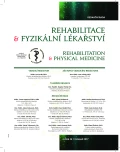The Use of Kinesio Taping in Overload of Physiotherapist’s Thumb
Authors:
M. Šorfová 1; E. Tlapáková 1; A. Neklanová 1; D. Ravnik 2
Authors‘ workplace:
Katedra anatomie a biomechaniky, Fakulta tělesné výchovy a sportu Univerzity Karlovy v Praze
1; University of Primorska, Faculty of Health Sciences, Slovinsko
2
Published in:
Rehabil. fyz. Lék., 24, 2017, No. 4, pp. 226-233.
Category:
Original Papers
Overview
Introduction:
Physiotherapy is a challenging work from psychical as well as physical point of view. Due to their working load, many physiotherapists encounter problems with locomotor apparatus and their hands are overloaded in particular. According to various authors (13,18) thumbs are particularly overburdened. The main purpose of this research therefore concerned comparison of metacarpal joint pain of the thumb (further MCP) with and without kinesio taping. Objectification of the results was simultaneously evaluated by a grip difference by measured a hand dynamometer.
Methodology:
The group included 14 female physiotherapists at the age of 25 to 32 years (mean age 29.3). All of them were employed at the same workplace, which guaranteed the same duration of the work shift and similar content of the work. Each therapist was required to cope with 73 patients weekly, individual mostly manual therapies lasted 30 minutes. The probands were divided in two groups, 7 persons each based on whether they experienced or did not encounter pains of the MCP joints of the thumb, wrist and elbow. In the course of 14 day working cycle, the grip strength was repeatedly measured by a hand dynamometer at the beginning and at the end of each working day. Each probands simultaneously recorded the degree of experienced pain in a standardized questionnaire Numeric Pain Rating Scale (NPRS) on the scale 1-10 (0 = no pain, 7-10 = great pain). In the course of the research the authors collected 12824 data concerning soreness and 560 values of the recorded strength, which were than statistically processed and evaluated by the paired t-test., Wilcoxon test and Pearson correlation coefficient.
Results and conclusion:
The results revealed that using kineso taping prevents a decrease in the grip strength at the end of the working day not only in the group feeling pain of at work, but also in the group in which such pain was not encountered. We the demonstrated a decrease of the pain in MCP joint of the thumb in the course of the work and afterwards in both groups under observation. The importance of the kinesio taping is therefore curative as well as preventive.
KEYWORDS:
kinesio taping metacarpal joint of the thumb, pain, hand grip strength
Sources
1 AMARAL, J. F., MANCINI, M., NOVO, J. M.: Comparison of three hand dynamometers in relation to the accuracy and precision of the measurements. Brazilian Journal of Physical Therapy, roč. 16, 2012, č. 4, s. 216-224.
2. BOHANNON, R. W. et al.: Reference values for adult grip strength measured with a Jamar dynamometer: a descriptive meta-analysis. Physiotherapy, roč. 92, 2006, č. 1, s. 11-15.
3. CARAGIANIS, S.: The prevalence of occupational injuries among hand therapists in Australia and New Zealand. Journal of HAand Therapy, roč. 15, 2002, č. 3, s. 234-241.
4. DOLEŽALOVÁ, R., PĚTIVLAS, T.: Kinesiotaping pro sportovce: sportujeme bez bolesti. 1. vyd. Praha, Grada, 2011, 95 s. Fitness, síla, kondice. ISBN 978-80-247-3636-5.
5. GERODIMOS, V.: Reliability of handgrip strength test in basketball players. Journal of Human Kinetics, roč. 31, 2012, s. 25-36.
6. HNÍZDIL, J., LICHTENBERG, M.: Taping–progresivní metoda fixace pohybového aparátu, 1989, Metodický dopis Praha, Československý svaz tělesné výchovy.
7. JONES, G., COOLEY, H., BELLAMY, N.: A cross-sectional study of the association between Heberden‘s nodes, radiographic osteoarthritis of the hands, grip strength, disability and pain. Osteoarthritis and Cartilage, roč. 9, 2001, č. 7, s. 606-611.
8. KOBROVÁ, J., VÁLKA, R.: Terapeutické využití kinesio tapu. 1. vyd. Prah,: Grada, 2012, 153 s., ISBN 978-80-247-4294-6.
9. KOLÁŘ, P.: Rehabilitace v klinické praxi. Praha, Galén, 2009, ISBN 978-80-7262-657-1.
10. LEMOS, T. V. et al.: The effect of Kinesio Taping on handgrip strength. Journal of Physical Therapy Science, roč. 27, 2015, č. 3, s. 567-570.
11. PÁRAL, J.: Malý atlas obvazových technik. Praha, Grada Publishing, a.s., 2008.
12. SALAFFI, F. et al.: Minimal clinically important changes in chronic musculoskeletal pain intensity measured on a numerical rating scale. European Journal of Pain, roč. 8, 2004, č. 4, s. 283-291.
13. SNODGRASS, S. J. et al.: Factors related to thumb pain in physiotherapists. Australian Journal of Physiotherapy, roč. 49, 2003, č. 4, s. 243-250.
14. STOKES, M., YOUNG, A.: The contribution of reflex inhibition to arthrogenous muscle weakness. Clinical Science, roč. 67, 1984, č. 1, s. 7-14.
15. ŠIMKOVÁ, I., PÁNEK, D., PAVLŮ, D.: EMG analýza vybraných svalů ruky při psaní krátkých textových zpráv na mobilním telefonu. Rehabilitace a fyzikální lékařství, 18, 2011, s. 59-68
16. Taheel Technology Company – produkt Takei A5401 – dostupné http://www.taheeltech.com/product/hand-held-electronic-dynamometer/
17. VRBOVÁ, M., PAVLŮ, D., PÁNEK, D.: Vliv tapu aplikovaného v průběhu svalových vláken na aktivitu pod ním ležícího svalu. Rehabil. fyz. Lék., roč. 18, 2011, č. 2, s. 87-96.
18. WAJON, A., ADA, L.: Prevalence of thumb pain in physical therapists practicing spinal manipulative therapy. Journal of Hand Therapy, roč. 16, 2003, č. 3, s. 237-244.
19. WILLIAMSON, A., HOGGART, B.: Pain: a review of three commonly used pain rating scales. Journal of Clinical Nursing, roč. 14, 2005, č. 7, s. 798-804.
Labels
Physiotherapist, university degree Rehabilitation Sports medicineArticle was published in
Rehabilitation & Physical Medicine

2017 Issue 4
- Hope Awakens with Early Diagnosis of Parkinson's Disease Based on Skin Odor
- Deep stimulation of the globus pallidus improved clinical symptoms in a patient with refractory parkinsonism and genetic mutation
Most read in this issue
- Benefits and Drawbacks of Combined Therapy
- Assessment of Balance in Patients with Parkinson‘s Disease in Clinical Physiotherapeutic Practice
- Influence of Functional Electric Stimulation on the Hand Motoric after Cerebrovasvascular Event (stroke) a Preclinical Study
- The Use of Kinesio Taping in Overload of Physiotherapist’s Thumb
